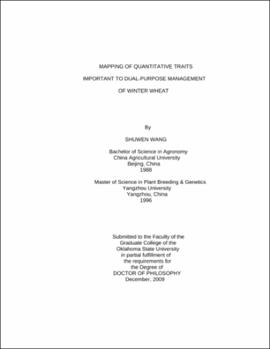| dc.contributor.advisor | Carver, Brett | |
| dc.contributor.author | Wang, Shuwen | |
| dc.date.accessioned | 2013-12-10T18:04:40Z | |
| dc.date.available | 2013-12-10T18:04:40Z | |
| dc.date.issued | 2009-12 | |
| dc.identifier.uri | https://hdl.handle.net/11244/7755 | |
| dc.description.abstract | Scope and Method of Study: | |
| dc.description.abstract | In the southern Great Plains, winter wheat is widely used for forage-plus-grain production. Knowledge of the genetic control of traits important to dual-purpose management would facilitate breeding efforts leading to better adapted cultivars. Linkage mapping was conducted on 94 recombinant inbred lines derived from two locally adapted cultivars, 'Intrada' and 'Cimarron'. Single-marker analysis and interval mapping methods were applied to identify putative QTLs. Traits including initial stem elongation, heading date, and high-temperature seed dormancy, were investigated in the field at Stillwater, Oklahoma from 2004 to 2007. | |
| dc.description.abstract | Findings and Conclusions: | |
| dc.description.abstract | A linkage map was completed with 243 SSR, SNP, or gene markers, covering 15 wheat chromosomes and uncharacterized small linkage groups. Three QTLs in the photoperiod pathway interactively regulated both initial stem elongation and heading. The Intrada Xbarc200 and Xcfd14 alleles and the Cimarron PPD-D1 allele accelerated stem elongation and heading stages; conversely, the Cimarron Xbarc200 and Xcfd14 alleles and the Intrada PPD-D1 allele delayed stem elongation and heading stages. Regarding high-temperature seed dormancy, two major QTLs were detected on chromosomes 3AS and 4AL, matching QTLs previously known to control warm temperature seed dormancy. The Cimarron Xbarc310 and Xzxq118 alleles promoted sensitivity to high temperature. Grain color had no significant association with expression of high-temperature seed dormancy. Our results showed that initial stem elongation vs. heading, or high vs. warm temperature seed dormancy, were interrelated by common genetic loci. Careful selection of alleles is required to enhance the adaptation of winter wheat to dual-purpose management systems. | |
| dc.format | application/pdf | |
| dc.language | en_US | |
| dc.rights | Copyright is held by the author who has granted the Oklahoma State University Library the non-exclusive right to share this material in its institutional repository. Contact Digital Library Services at lib-dls@okstate.edu or 405-744-9161 for the permission policy on the use, reproduction or distribution of this material. | |
| dc.title | Mapping of quantitative traits important to dual-purpose management of winter wheat | |
| dc.contributor.committeeMember | Yan, Liuling | |
| dc.contributor.committeeMember | Bai, Guihua | |
| dc.contributor.committeeMember | Edwards, Jeff | |
| osu.filename | Wang_okstate_0664D_10614.pdf | |
| osu.accesstype | Open Access | |
| dc.type.genre | Dissertation | |
| dc.type.material | Text | |
| dc.subject.keywords | first hollow stem | |
| dc.subject.keywords | heading | |
| dc.subject.keywords | high temperature seed dormancy | |
| dc.subject.keywords | initial stem elongation | |
| dc.subject.keywords | mapping | |
| dc.subject.keywords | winter wheat | |
| thesis.degree.discipline | Crop Science | |
| thesis.degree.grantor | Oklahoma State University | |
